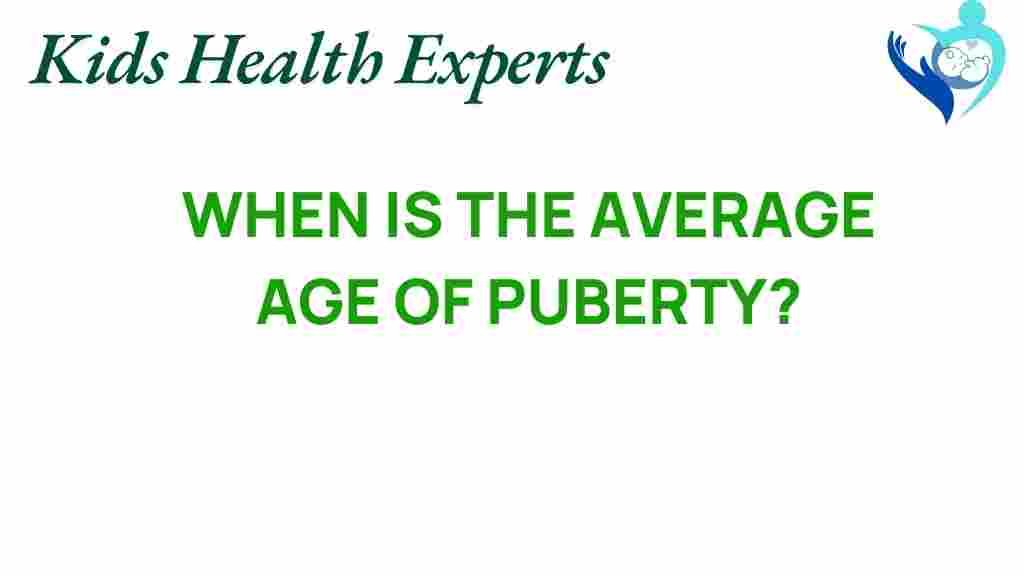Unveiling the Secrets: What is the Average Age of Puberty?
The journey through childhood to adulthood is marked by significant changes, one of the most critical being puberty. Understanding puberty, its average age, and the accompanying developmental milestones is essential for parents, educators, and adolescents themselves. This article will explore the average age of puberty, the hormonal changes involved, and the importance of parental guidance during this transformative stage.
Understanding Puberty
Puberty is a natural phase of human development characterized by physical, emotional, and psychological changes. It marks the transition from childhood to adolescence and eventually to adulthood. During puberty, individuals experience a series of developmental milestones that are crucial for their overall growth.
The Average Age of Puberty
The average age of puberty varies among individuals, but it generally occurs between the ages of:
- **Girls:** 8 to 13 years old
- **Boys:** 9 to 14 years old
While these age ranges serve as a guideline, it’s important to note that each child develops at their own pace. Factors such as genetics, nutrition, and environmental influences can significantly affect the timing of puberty.
Developmental Milestones During Puberty
Puberty is marked by various developmental milestones that reflect the physical and psychological changes occurring in children. These milestones can be categorized into several key areas:
- Physical Growth: This includes a growth spurt where both boys and girls experience rapid increases in height and weight.
- Secondary Sexual Characteristics: In girls, this includes breast development and the onset of menstruation. In boys, it includes testicular enlargement and growth of facial hair.
- Hormonal Changes: The body undergoes significant hormonal changes, primarily involving estrogen in girls and testosterone in boys, leading to various physical and emotional developments.
- Emotional and Social Changes: Adolescents may experience heightened emotions, mood swings, and a growing awareness of their identity and relationships.
The Growth Spurt: A Key Component of Puberty
One of the most noticeable aspects of puberty is the growth spurt. During this time, children can grow several inches in a short period. The growth spurt typically occurs earlier in girls than in boys, with girls usually experiencing it around ages 9 to 11 and boys around ages 11 to 13.
The growth spurt is driven by hormonal changes and can significantly impact a child’s physical appearance and self-esteem.
Hormonal Changes During Puberty
Hormonal changes are at the core of puberty. The hypothalamus in the brain signals the pituitary gland to release hormones that stimulate the gonads (ovaries in girls and testes in boys) to produce sex hormones. These hormones play a crucial role in developing secondary sexual characteristics and initiating the growth spurt.
- Estrogen: In girls, estrogen promotes breast development, the widening of hips, and the regulation of the menstrual cycle.
- Testosterone: In boys, testosterone is responsible for muscle growth, deepening the voice, and the development of facial and body hair.
Health Considerations During Adolescence
As children transition into adolescence, several health considerations arise. Understanding the average age of puberty and its implications can help parents and educators support adolescents effectively. Here are some key health considerations:
- Nutritional Needs: Adolescents require a balanced diet rich in vitamins and minerals to support their rapid growth. Parents should encourage healthy eating habits.
- Mental Health: The emotional rollercoaster of puberty can lead to anxiety and depression. Open communication and support from parents and educators are vital.
- Physical Activity: Regular exercise is essential for physical development and mental well-being. Encourage participation in sports or other physical activities.
Education on Puberty: The Role of Schools
Education about puberty and its associated changes is crucial for adolescents. Schools play a significant role in providing accurate information about developmental milestones, hormonal changes, and health considerations. Implementing comprehensive sex education programs can help:
- Foster a better understanding of puberty and the changes that accompany it.
- Encourage healthy attitudes towards body image and self-esteem.
- Promote open discussions about relationships, consent, and emotional health.
For more information on puberty education, you can visit this resource.
Parental Guidance: Supporting Your Child Through Puberty
As parents, providing guidance during your child’s puberty is crucial. Here are some tips to support your child effectively:
- Open Communication: Encourage your child to express their feelings and concerns about the changes they are experiencing.
- Provide Information: Educate your child about puberty, including what to expect and how to manage emotional and physical changes.
- Be Supportive: Validate their feelings and reassure them that what they are going through is normal.
- Encourage Healthy Habits: Promote a balanced diet, regular exercise, and good sleep hygiene to support their overall health.
Troubleshooting Common Concerns
Parents and educators may encounter various concerns during puberty. Here are some common issues and suggestions for addressing them:
- Delayed Puberty: If a child has not shown signs of puberty by the average age, consult a healthcare provider to rule out any underlying health issues.
- Body Image Issues: Adolescents may struggle with body image due to the rapid changes they experience. Encourage a positive body image by focusing on abilities and health rather than appearance.
- Emotional Instability: Mood swings are common during puberty. Encourage your child to express their emotions and offer support during tough times.
Conclusion: Embracing the Journey of Puberty
Puberty is a significant phase in every child’s life, marked by various developmental milestones, hormonal changes, and a growth spurt. Understanding the average age of puberty and the associated changes can help parents, educators, and adolescents navigate this transition more effectively. By fostering open communication, providing education, and offering support, we can ensure that children embrace this journey with confidence and resilience.
For further reading on adolescent health and development, consider checking out this external resource.
This article is in the category Growth and created by KidsHealthExperts Team
